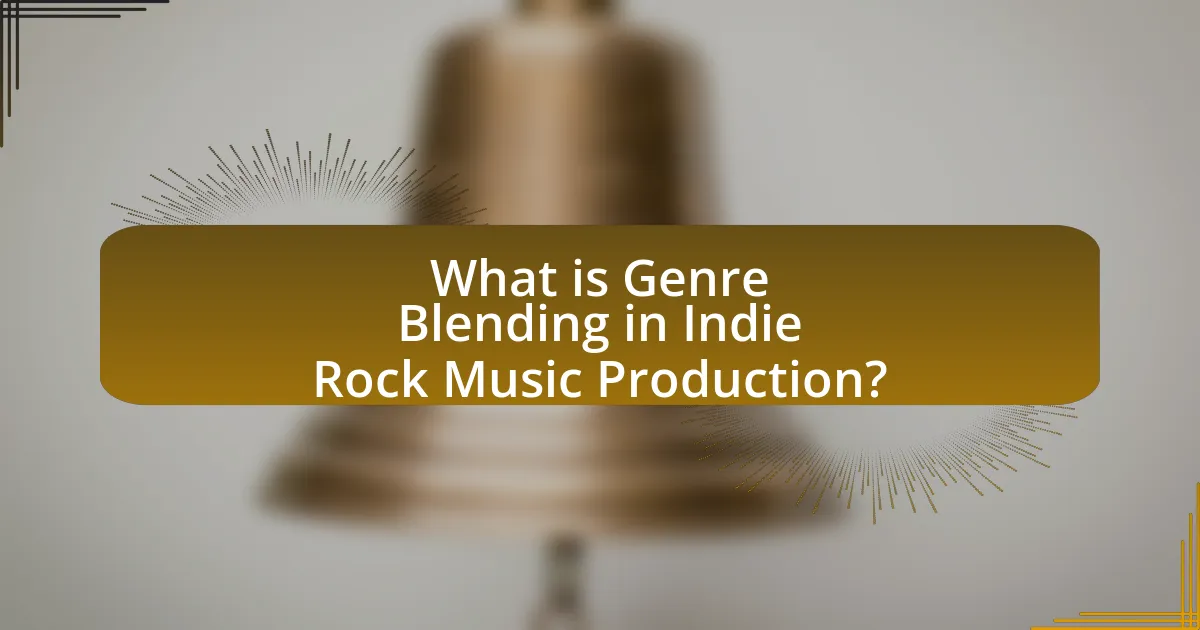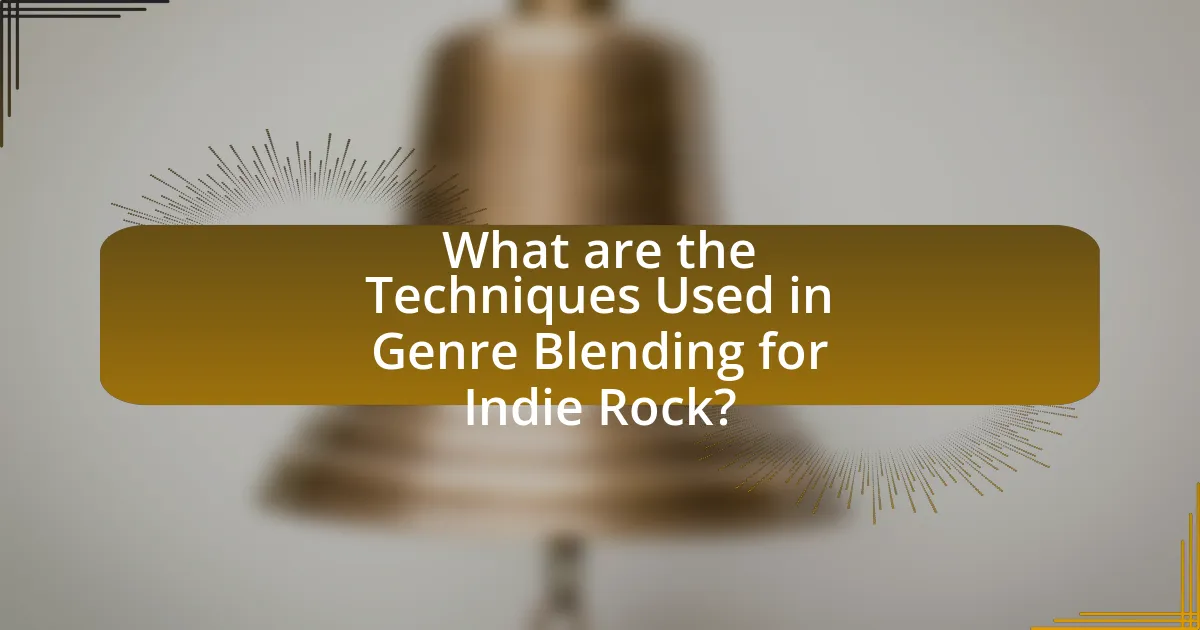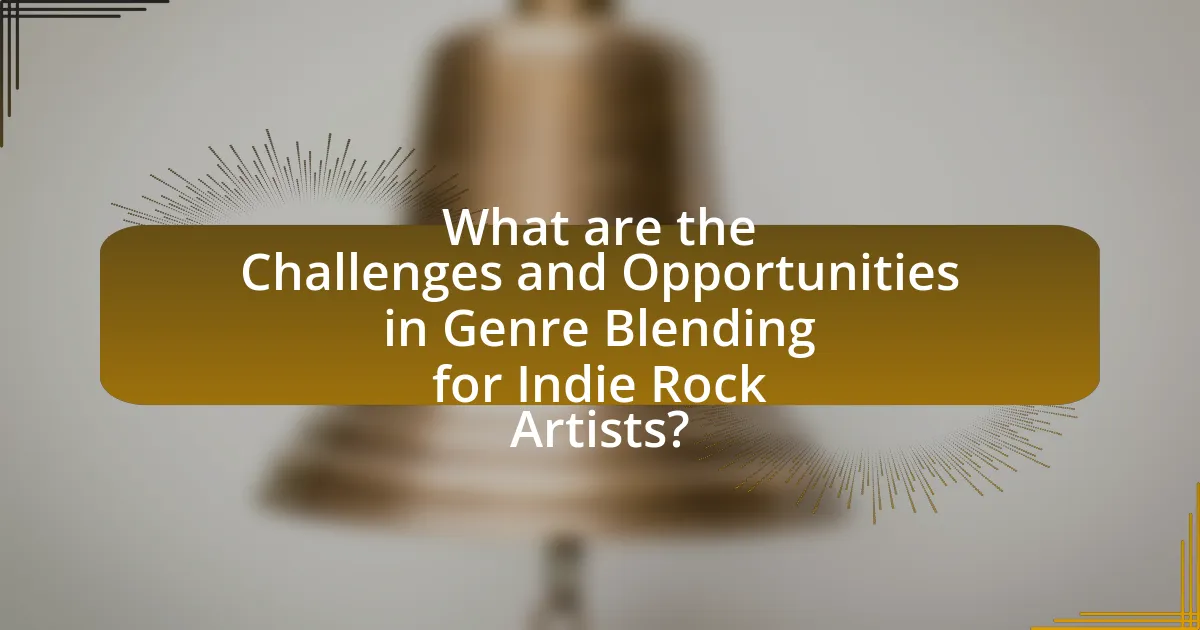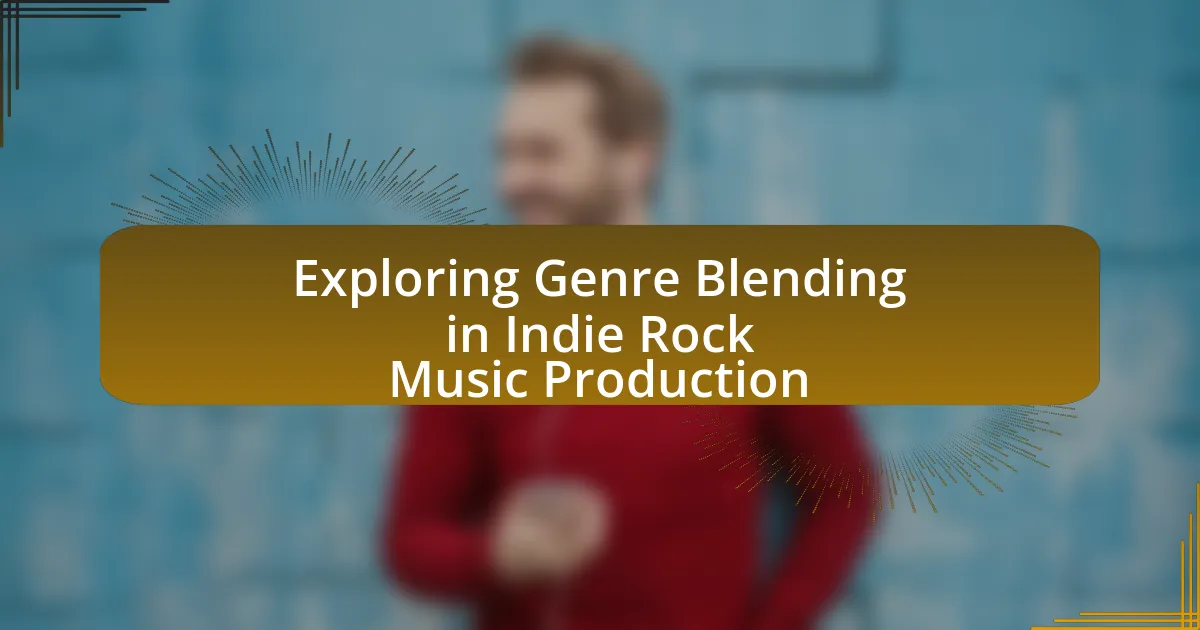Genre blending in indie rock music production involves the integration of diverse musical elements from various genres, such as folk, electronic, punk, and jazz, into the indie rock framework. This practice enhances creativity and allows artists to create unique sounds that challenge traditional genre boundaries, as exemplified by bands like Arcade Fire and Sufjan Stevens. The article explores how genre blending influences the sound of indie rock, the key characteristics of the genre, and the cultural factors driving this evolution. It also discusses the techniques used in genre blending, the challenges and opportunities it presents for artists, and best practices for maintaining a unique identity while experimenting with different styles.

What is Genre Blending in Indie Rock Music Production?
Genre blending in indie rock music production refers to the incorporation of elements from various musical genres into the indie rock framework. This practice allows artists to create unique sounds by merging influences from genres such as folk, electronic, punk, and jazz, resulting in innovative compositions that challenge traditional genre boundaries. For instance, bands like Arcade Fire and Sufjan Stevens exemplify genre blending by integrating orchestral arrangements and electronic beats into their indie rock sound, showcasing the versatility and creativity inherent in this approach.
How does genre blending influence the sound of indie rock music?
Genre blending significantly influences the sound of indie rock music by incorporating diverse musical elements from various genres, resulting in a unique and innovative auditory experience. This fusion allows indie rock artists to experiment with different rhythms, instrumentation, and vocal styles, which can lead to the creation of sub-genres such as indie pop, folk rock, and electronic indie. For instance, the incorporation of electronic elements in bands like The Postal Service showcases how blending genres can create a distinct sound that appeals to a broader audience. Additionally, the influence of punk and folk music in indie rock has led to a more raw and authentic sound, as seen in the works of artists like Bon Iver and Fleet Foxes, who combine traditional acoustic elements with modern production techniques. This genre blending not only enhances creativity but also reflects the evolving nature of music consumption and production in contemporary culture.
What are the key characteristics of indie rock music?
Indie rock music is characterized by its emphasis on independent production, diverse musical influences, and a DIY ethos. This genre often features unconventional song structures, a focus on lyrical content, and a blend of various styles, including punk, folk, and electronic elements. Historically, indie rock emerged in the 1980s as a response to mainstream music, with bands like R.E.M. and The Smiths exemplifying its distinct sound. The genre’s independent nature allows for artistic freedom, leading to innovative approaches in instrumentation and production techniques.
How do different genres contribute to the evolution of indie rock?
Different genres contribute to the evolution of indie rock by introducing diverse musical elements, structures, and influences that reshape its sound. For instance, the incorporation of punk’s raw energy and DIY ethos has led to a more aggressive and authentic indie rock style, while the infusion of electronic music has expanded its sonic palette, allowing for innovative production techniques. Additionally, the blending of folk elements has introduced acoustic instrumentation and storytelling, enriching the lyrical depth of indie rock. Historical examples include the influence of grunge in the 1990s, which brought a heavier sound, and the rise of lo-fi aesthetics in the early 2000s, which emphasized a more personal and experimental approach. These genre interactions not only diversify indie rock but also reflect broader cultural shifts, making it a dynamic and evolving genre.
Why is genre blending significant in the indie rock scene?
Genre blending is significant in the indie rock scene because it fosters innovation and diversity in musical expression. By combining elements from various genres such as folk, punk, electronic, and jazz, indie rock artists create unique sounds that challenge traditional boundaries. This blending not only attracts a wider audience but also encourages collaboration among musicians, leading to the emergence of new subgenres. For instance, the rise of bands like Bon Iver, which incorporates folk and electronic influences, exemplifies how genre blending can redefine artistic identity and expand listener engagement.
What cultural factors drive genre blending in indie rock?
Cultural factors driving genre blending in indie rock include the rise of digital technology, increased access to diverse musical influences, and the DIY ethos prevalent in the indie music scene. Digital platforms allow artists to experiment with various styles and collaborate across genres, leading to innovative soundscapes. Additionally, the globalization of music has exposed indie rock musicians to a wide array of cultural sounds, encouraging them to incorporate elements from genres such as hip-hop, electronic, and world music. The DIY ethos fosters a spirit of experimentation and collaboration, enabling artists to break traditional genre boundaries and create unique blends that reflect their personal and cultural identities.
How does genre blending affect audience reception of indie rock music?
Genre blending positively affects audience reception of indie rock music by broadening its appeal and enhancing listener engagement. When indie rock artists incorporate elements from various genres, such as electronic, folk, or hip-hop, they create a more diverse sound that attracts a wider audience. This diversity can lead to increased streaming numbers and concert attendance, as listeners are drawn to the innovative combinations that challenge traditional genre boundaries. For instance, the success of bands like Bon Iver, which blends indie rock with folk and electronic influences, demonstrates how genre blending can resonate with both indie rock fans and those from other musical backgrounds, ultimately expanding the listener base and fostering a more inclusive music culture.

What are the Techniques Used in Genre Blending for Indie Rock?
Techniques used in genre blending for indie rock include the incorporation of diverse musical elements, such as combining acoustic and electronic instrumentation, utilizing unconventional song structures, and integrating various vocal styles. For instance, artists often blend folk elements with electronic beats, creating a unique sound that defies traditional genre boundaries. This approach is supported by the rise of artists like Bon Iver, who merges indie rock with folk and electronic influences, showcasing the effectiveness of genre blending in expanding musical creativity and appeal.
How do producers implement genre blending in their music?
Producers implement genre blending in their music by combining elements from different musical styles to create a unique sound. This is achieved through techniques such as layering instruments from various genres, incorporating diverse rhythms, and experimenting with vocal styles. For instance, a producer might blend rock guitar riffs with electronic beats, as seen in the works of artists like Beck, who often merges folk, hip-hop, and electronic music. This approach not only broadens the sonic palette but also attracts a wider audience, as evidenced by the commercial success of genre-blending tracks that chart across multiple music categories.
What role do instrumentation and arrangement play in genre blending?
Instrumentation and arrangement are crucial in genre blending as they define the sonic palette and structural framework of a piece. Different genres utilize distinct instruments and arrangements, which can be combined to create innovative sounds that transcend traditional boundaries. For instance, incorporating electronic elements into a rock arrangement can produce a hybrid sound that appeals to fans of both genres. This blending is evident in artists like Radiohead, who fuse rock with electronic music, showcasing how varied instrumentation and thoughtful arrangement can enhance genre fusion.
How do vocal styles vary across blended genres in indie rock?
Vocal styles in blended genres of indie rock vary significantly, reflecting the influences of different musical traditions. For instance, when indie rock incorporates elements of folk, vocal delivery often becomes more narrative and emotive, characterized by softer tones and storytelling techniques. In contrast, when blended with punk, vocal styles may adopt a more aggressive and raw approach, featuring higher energy and a confrontational attitude. Additionally, the integration of electronic music can lead to the use of processed vocals, including pitch correction and layering, which creates a more polished and experimental sound. These variations are evident in artists like Bon Iver, who blends folk and electronic elements, and Arctic Monkeys, who incorporate garage rock influences, showcasing how vocal styles adapt to the characteristics of the genres they blend with.
What production tools facilitate genre blending in indie rock?
Digital audio workstations (DAWs) such as Ableton Live, Logic Pro, and Pro Tools facilitate genre blending in indie rock by providing versatile platforms for recording, editing, and mixing diverse musical elements. These DAWs support various plugins and virtual instruments that allow artists to incorporate sounds from different genres, such as electronic beats, orchestral arrangements, or hip-hop samples, seamlessly into their tracks. For instance, the use of MIDI controllers and synthesizers enables indie rock musicians to experiment with electronic textures, while effects plugins like reverb and delay can create atmospheric layers that enhance genre fusion. This flexibility in production tools has been pivotal in the evolution of indie rock, allowing artists to push creative boundaries and explore innovative soundscapes.
Which software and hardware are commonly used in genre blending?
Commonly used software for genre blending includes digital audio workstations (DAWs) like Ableton Live, Logic Pro, and Pro Tools, which facilitate the integration of various musical styles. Hardware often utilized in this process includes synthesizers such as the Moog Sub 37 and drum machines like the Roland TR-808, which provide diverse sound palettes essential for blending genres. These tools enable artists to experiment with different sounds and techniques, allowing for innovative combinations that define genre-blending music.
How do mixing and mastering techniques enhance genre blending?
Mixing and mastering techniques enhance genre blending by allowing distinct musical elements from various genres to coexist harmoniously within a single track. Through careful equalization, dynamic range control, and spatial effects, mixing can emphasize the unique characteristics of each genre, such as the punchy drums of rock or the smooth synths of electronic music. Mastering further refines this blend by ensuring that the final product maintains a cohesive sound across different playback systems, which is crucial for genres that may have contrasting sonic qualities. For instance, a study by the Audio Engineering Society highlights that effective mastering can balance the loudness and tonal quality of mixed tracks, making genre transitions seamless and enhancing listener experience.

What are the Challenges and Opportunities in Genre Blending for Indie Rock Artists?
Genre blending presents both challenges and opportunities for indie rock artists. The primary challenge lies in maintaining a coherent artistic identity while integrating diverse musical elements, which can lead to confusion among audiences. For instance, artists may struggle to balance their core indie rock sound with influences from genres like electronic or hip-hop, risking alienation of their existing fan base. Conversely, the opportunity in genre blending allows indie rock artists to innovate and reach broader audiences by appealing to fans of multiple genres. This cross-genre appeal can enhance their marketability and lead to collaborations that enrich their music. A notable example is the band Twenty One Pilots, which successfully blends rock, pop, and hip-hop, resulting in widespread commercial success and critical acclaim.
What challenges do artists face when blending genres in indie rock?
Artists face several challenges when blending genres in indie rock, primarily including audience expectations, identity confusion, and production complexities. Audience expectations can create pressure to conform to established genre norms, making it difficult for artists to innovate without alienating their fan base. Identity confusion arises when artists struggle to define their sound, leading to potential misinterpretation of their music by listeners and critics. Additionally, production complexities involve navigating different musical techniques and instrumentation, which can complicate the recording process and require a diverse skill set. These challenges highlight the intricate balance artists must maintain while attempting to create a unique sound within the indie rock genre.
How can genre blending lead to creative conflicts among band members?
Genre blending can lead to creative conflicts among band members due to differing artistic visions and preferences. When members have distinct backgrounds in various genres, such as rock, jazz, or electronic, their interpretations of how to merge these styles can clash, resulting in disagreements over song structure, instrumentation, and overall sound. For instance, a member who favors a traditional rock approach may resist incorporating elements from hip-hop, leading to tension. This phenomenon is supported by research indicating that collaboration in genre-blending contexts often requires negotiation and compromise, which can be challenging when individual members are strongly attached to their musical identities.
What are the risks of alienating traditional indie rock fans?
Alienating traditional indie rock fans risks losing a dedicated audience that values authenticity and genre conventions. This demographic often appreciates the raw, unpolished sound and lyrical depth characteristic of traditional indie rock. When artists shift towards genre blending, they may produce music that feels commercialized or disconnected from the roots of indie rock, leading to fan disillusionment. Historical examples include bands like Radiohead, which faced backlash from purists when they experimented with electronic elements, demonstrating that significant stylistic changes can alienate core supporters. Additionally, a 2020 survey by the Music Industry Research Association indicated that 65% of indie rock fans prefer music that adheres to traditional indie aesthetics, underscoring the potential backlash against genre deviation.
What opportunities arise from successful genre blending in indie rock?
Successful genre blending in indie rock creates opportunities for artistic innovation, audience expansion, and market differentiation. By merging diverse musical styles, artists can develop unique sounds that attract listeners from various genres, thereby broadening their fan base. For instance, bands like Alt-J and Tame Impala have successfully integrated elements of electronic, pop, and psychedelic music into their indie rock, resulting in critical acclaim and commercial success. This blending not only enhances creativity but also positions artists to stand out in a saturated market, as they offer something distinct that resonates with a wider audience.
How can genre blending expand an artist’s audience reach?
Genre blending can expand an artist’s audience reach by attracting diverse listener demographics who appreciate multiple musical styles. When artists incorporate elements from various genres, such as rock, hip-hop, and electronic music, they create a unique sound that resonates with fans from different backgrounds. For instance, the collaboration between artists like Billie Eilish and Khalid, who blend pop with R&B and electronic influences, has garnered them a wider audience, evidenced by their chart-topping hits and streaming numbers. This cross-genre appeal not only increases their fan base but also enhances their visibility across different music platforms and festivals, ultimately leading to greater commercial success.
What collaborations can emerge from genre blending in indie rock?
Genre blending in indie rock can lead to collaborations between artists from diverse musical backgrounds, such as electronic, folk, hip-hop, and jazz. These collaborations often result in innovative soundscapes that push the boundaries of traditional indie rock. For instance, the partnership between indie rock bands and electronic producers has produced successful albums that incorporate synthesized sounds and beats, exemplified by the collaboration between The xx and Jamie xx. Additionally, artists like Sufjan Stevens have worked with orchestral musicians, merging indie rock with classical elements, showcasing how genre blending can create unique musical experiences. Such collaborations not only enhance creativity but also expand the audience reach by appealing to fans of multiple genres.
What are some best practices for successfully blending genres in indie rock music production?
To successfully blend genres in indie rock music production, artists should prioritize experimentation with instrumentation and arrangement. This involves incorporating diverse instruments from various genres, such as electronic elements or orchestral strings, to create a unique sound palette. Additionally, maintaining a cohesive sonic identity is crucial; artists can achieve this by ensuring that the production techniques, such as mixing and mastering, align with the overall aesthetic of the project.
Furthermore, collaboration with musicians from different genres can introduce fresh perspectives and techniques, enhancing the blending process. For instance, working with a jazz musician may bring improvisational elements that enrich the indie rock framework. Lastly, analyzing successful genre-blending artists, such as Radiohead or Beck, can provide insights into effective methods and inspire innovative approaches in production.
How can artists maintain their unique identity while blending genres?
Artists can maintain their unique identity while blending genres by integrating personal experiences and distinctive stylistic elements into their music. This approach allows them to create a sound that reflects their individuality, even when incorporating diverse influences. For instance, artists like Beck and St. Vincent have successfully fused various genres while retaining their signature sounds, showcasing how personal storytelling and unique instrumentation can preserve identity amidst genre blending.
What strategies can producers use to experiment with genre blending effectively?
Producers can experiment with genre blending effectively by incorporating diverse musical elements, utilizing technology for sound manipulation, and collaborating with artists from different genres. By integrating instruments and stylistic features from various genres, such as combining rock with electronic or hip-hop elements, producers can create unique soundscapes. The use of digital audio workstations allows for innovative sound design and layering techniques, enabling producers to manipulate sounds in ways that transcend traditional genre boundaries. Collaborating with artists who have different musical backgrounds can also introduce fresh perspectives and ideas, fostering creativity and innovation in genre blending. This approach has been successfully employed by artists like Beck and Gorillaz, who have merged multiple genres to create distinctive musical identities.
